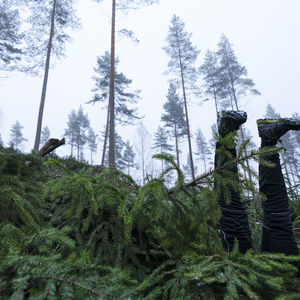Defence of dissertation in the field of Art Education, MA Henrika Ylirisku

When
Where
Event language(s)
Title of thesis: Reorienting Environmental Art Education
Opponent: PhD Pauliina Rautio, University of Oulu
Custos: Professor Mira Kallio-Tavin, Aalto University School of Arts, Design and Architecture, Department of Art
Defence is held remotely via Zoom: https://aalto.zoom.us/j/69573192303
Zoom Quick Guide: https://www.aalto.fi/en/services/zoom-quick-guide
The dissertation is publicly displayed online 10 days before the defence at:https://aaltodoc.aalto.fi/doc_public/eonly/riiputus/
More information on the thesis:
There are diverse approaches in visual art education for advancing sustainable ways of living, environmental awareness, and for studying the human-nature relation through the means of arts. This doctoral dissertation critically examines the theoretical-philosophical groundings of environmental art education. Are the existing approaches and conceptualizations sufficient in a time of ecological crises?
The dissertation points out that while environmental art education can be influential and comprehensive, its tradition is problematically tied to the presumptions of Western humanist thinking. The presumption of the human as exceptional and as autonomous individual brings along contradictions to the study of human-nature relations in environmental art education. Furthermore, some approaches run the risk of idealizing and romanticising nature.
The research develops a new direction for environmental art education. It suggests environmental art education to be founded on theories that allow unpacking human exceptionalism. There is a need for concepts and theories that acknowledge the complex entanglement of human and nature, nature and culture, and human and nonhuman. A research experiment based on orienteering is employed for tracing what future environmental art education can do.
It is important to focus on acknowledging multispecies relations and diverse interdependencies in future environmental art education. This further enables paying attention to ethics and responsibilities emerging in everyday multispecies, material encounters. Environmental art education can thus create new stories of lives in common worlds, beyond human mastery. It can bring queerness and complexity to the one-sided stories where humans only save and protect, or destroy and are careless.
The artistic approach enables approaching tensions and challenges of living through ecological crises through practices that are experimental, critical, creative, and bring thinking and making together. For art educators and others interested of linkages of art and environmental education, the research proposes a theoretical frame for developing further art pedagogical practices and research. It invites pedagogies that take into account undisciplined thinking, ambiguity, uncertainty and multiple ways of knowing.
More information: Henrika Ylirisku, [email protected]
- Published:
- Updated: